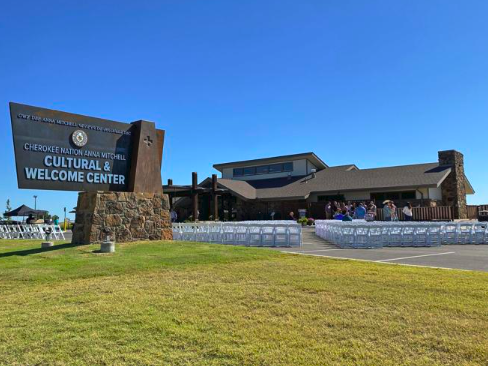
- Details
- By Chuck Hoskin Jr
Guest Opinion. Tourism is important for Cherokee Nation and all of northeast Oklahoma. Our tribe’s numerous museums and cultural sites simultaneously showcase and preserve our rich heritage while creating jobs and economic opportunities for many citizens.
The beautiful cultural art made by Cherokees is worth celebrating. As Principal Chief, I have taken an oath of office to preserve and defend our culture. It’s a responsibility I take very seriously because every county within our 7,000-square-mile reservation has significant cultural treasures.
The latest addition to Cherokee Nation’s cultural tourism footprint is the Cherokee Nation Anna Mitchell Cultural and Welcome Center, which we recently dedicated in Vinita. Located in Craig County, the 9,400-square-foot, two-story stone building is situated on 8 acres overlooking historic Route 66. It will celebrate Anna Mitchell’s legacy and be a gateway to all of Cherokee Nation along the iconic highway.
The center shares the history of both Cherokee Nation and the Vinita community while also honoring the late Anna Mitchell’s achievements in pottery and cultural preservation. She was widely known for her traditional, handmade pottery and for sharing her knowledge and artistic skills with others. Mitchell was a renowned artist and authority on both Southeastern and Eastern Woodlands-style pottery and was designated a Cherokee National Treasure in 1988.
The new center represents a $5 million investment that will be a beacon for Cherokee culture and art for a long time to come. We can all be proud of its positive and enduring impact on the local economy.

This first of its kind facility was the vision of Cherokee Nation First Lady January Hoskin, who has championed the expansion of access to Cherokee art and culture across the reservation and beyond. She saw an opportunity to bolster tourism and elevate Cherokee Nation’s presence along Route 66 in Vinita.
Seven Cherokee artists, including many National Treasures, are featured in the center’s inaugural exhibition, “Anna’s Legacy: A Cherokee Pottery Renaissance.” Each artist was influenced in some way by her. The center also boasts several original works of art as well as outdoor public art installations.
The space is a world-class venue to support talented Cherokee artists and artisans. They will be able to display their art to the public and sell it to supporters of the arts. Through Cherokee Nation’s operation of this facility, we will advertise Cherokee artists and help them carry our culture and our story throughout the world.
As global interest in Native American culture grows, it is important for tribes like Cherokee Nation to realize the benefits of sharing our unique heritage. Our mission is to preserve and promote Cherokee culture, and this state-of-the-art site allows us to do that better than ever. It also features a grab-and-go café with Native-inspired cuisine, a gift shop, and flexible space for cultural classes and events. It will be open to the public seven days a week from 9 a.m. to 5 p.m. For more information, please go to www.VisitCherokeeNation.com.
Our tribal culture and history connect us to the past, to all our ancestors who went before us, and it is what guides us toward our collective future. Anna Mitchell’s legacy lives on through her work and the way she inspired so many Cherokee artists. Now those artists have a new setting to showcase their work and inspire the next generation.
Chuck Hoskin, Jr. is the principal chief of the Cherokee Nation.
More Stories Like This
The Absence of October's Job Report Shows Why Native American Communities Need Better DataTribal IDs Are Federally Recognized. ICE Agents Are Ignoring Them.
Thanksgiving: Part of "Broken Circle Holiday"
Thanksgiving is a Tradition. It's Also a Lie
Decisions About Us, Without Us: Education Dismantling Ignores Tribal Nations
Help us defend tribal sovereignty.
At Native News Online, our mission is rooted in telling the stories that strengthen sovereignty and uplift Indigenous voices — not just at year’s end, but every single day.
Because of your generosity last year, we were able to keep our reporters on the ground in tribal communities, at national gatherings and in the halls of Congress — covering the issues that matter most to Indian Country: sovereignty, culture, education, health and economic opportunity.
That support sustained us through a tough year in 2025. Now, as we look to the year ahead, we need your help right now to ensure warrior journalism remains strong — reporting that defends tribal sovereignty, amplifies Native truth, and holds power accountable.
 The stakes couldn't be higher. Your support keeps Native voices heard, Native stories told and Native sovereignty defended.
The stakes couldn't be higher. Your support keeps Native voices heard, Native stories told and Native sovereignty defended.
Stand with Warrior Journalism today.
Levi Rickert (Potawatomi), Editor & Publisher

